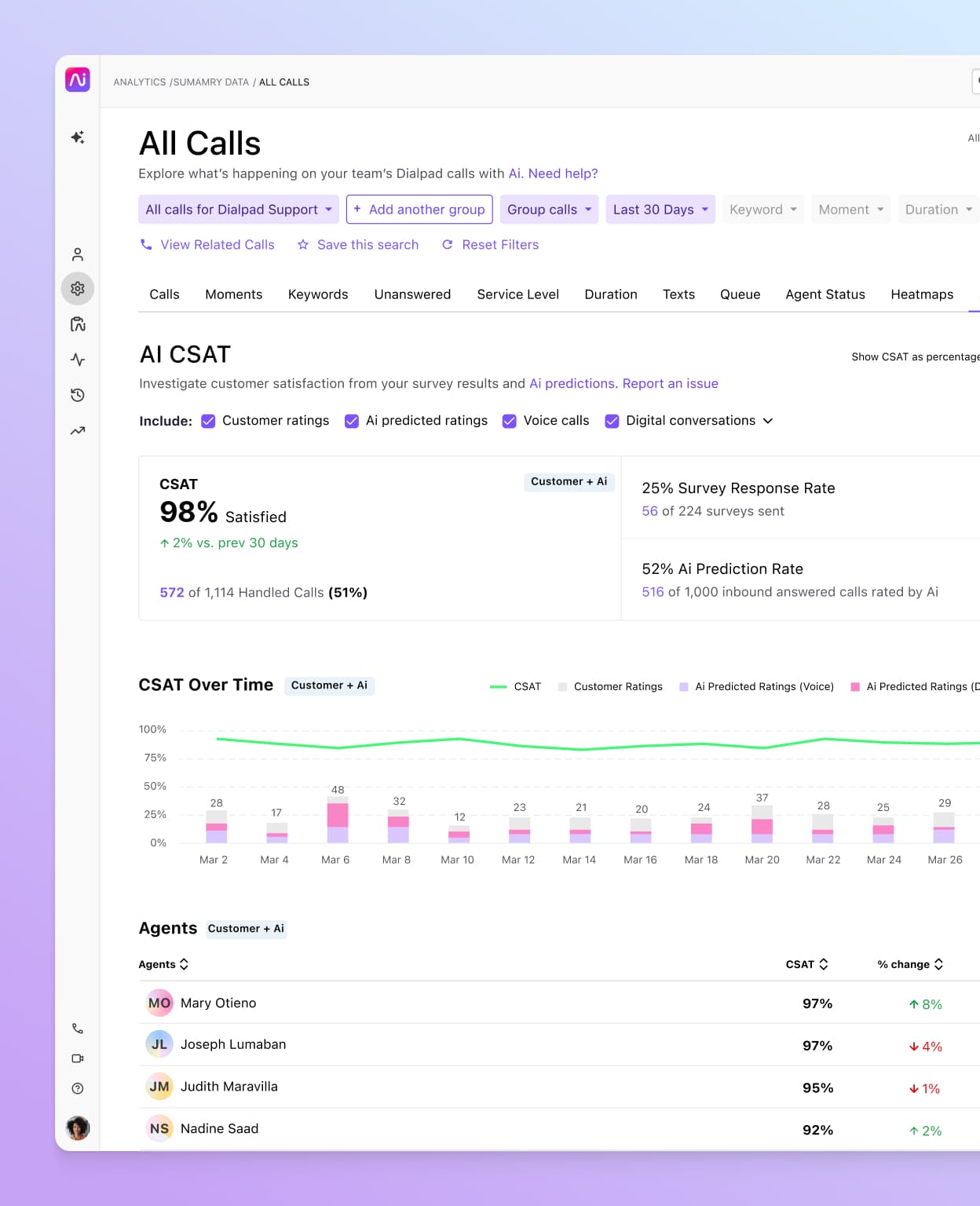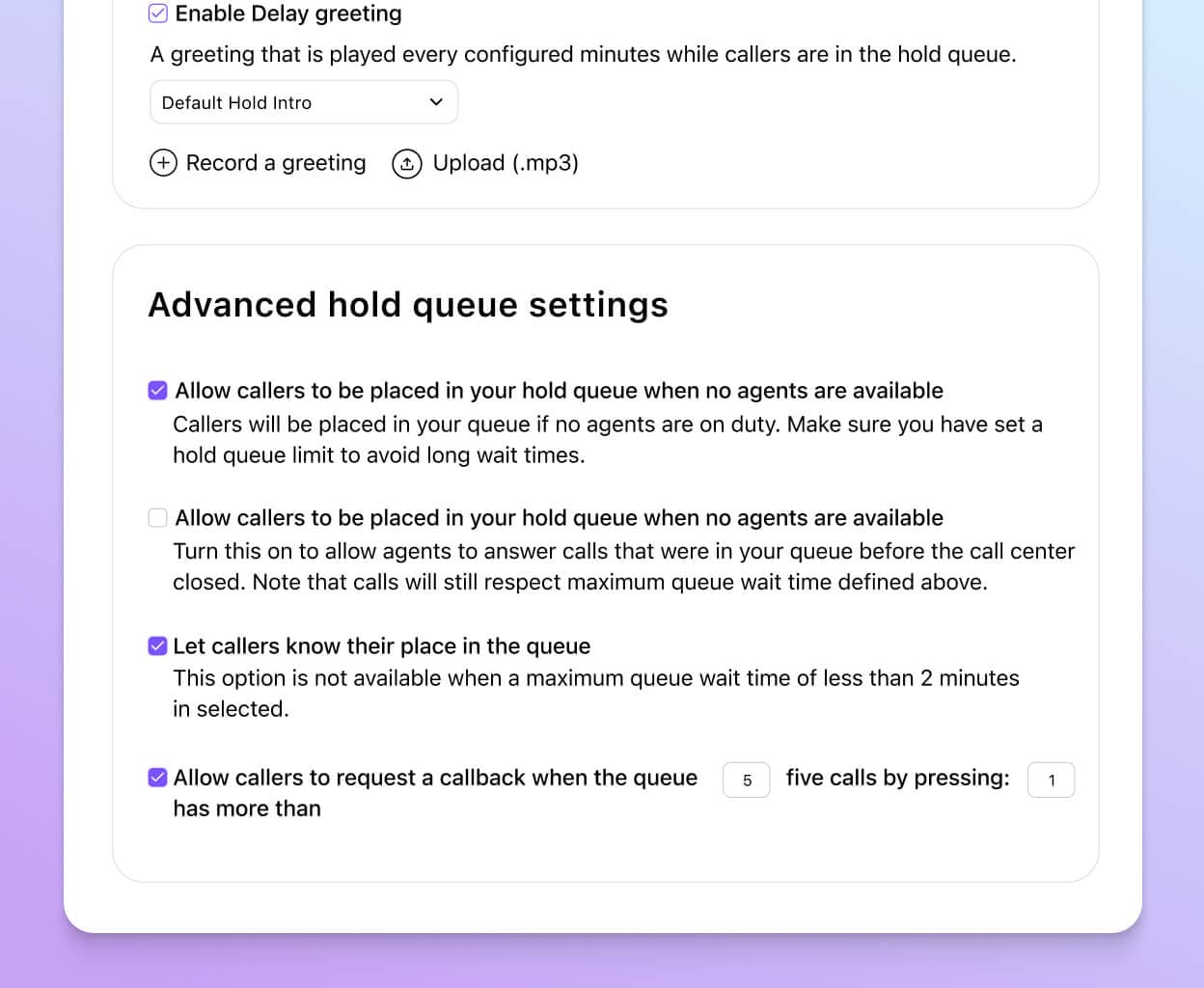Contact centre sentiment analysis
Whether your team is in sales or support, having a contact centre sentiment analysis feature in your platform is essential for helping managers and supervisors monitor active calls more easily (and jump in when needed). See how it works in Dialpad's AI-powered customer engagement platform by booking a product tour!

What is contact centre or call centre sentiment analysis?
Contact centre sentiment analysis is essentially a feature that has AI to analyse phone calls and customer conversations for words that suggest positive or negative sentiment in order to give supervisors a snapshot of how calls with customers or prospects are going—in real-time.
Often, this feature is powered by AI (as is the case with Dialpad, which has built its own proprietary artificial intelligence called Dialpad Ai) and you should be able to see it on a dashboard that displays sentiment across all live calls.
What are the benefits?
Live sentiment analysis is useful because it allows sales and support team managers to know exactly where their attention is needed in just a few seconds:

Often, supervisors oversee teams of tens or even hundreds of agents. With so many conversations happening simultaneously, how can they proactively know where their attention is needed or if an agent needs help?
Being able to view all the live calls, with an indicator of sentiment, lets them do exactly that. On the flip side, this also makes things a little easier for agents, who don't have to worry about manually messaging their supervisor for help because they know that the call sentiment will be visible already.
Features designed to make supervisors' and agents' lives easier
Manual call monitoring and running through QA checklists can be time-consuming and tedious, so how can supervisors and managers support agents more effectively? Dialpad's contact centre product comes with other features to help you do exactly that.
How to use sentiment analysis to improve contact center performance
Sentiment analysis is a powerful tool that helps contact centers enhance efficiency, agent performance, and customer satisfaction. Here are some practical ways to use sentiment analysis to improve performance:
1. Identify agents who need more training
One of the most valuable applications of sentiment analysis is its ability to highlight patterns in agent performance. By tracking sentiment trends over time, managers can see which agents consistently receive negative sentiment scores and may need additional training.
For example, if an agent frequently engages in calls where customers express frustration or dissatisfaction, supervisors can review call transcripts and recordings to identify the root cause (instead of waiting for customer complaints). The agent may need coaching on handling objections, de-escalating conflicts, or improving active listening skills.
2. Providing real-time support to agents
Live sentiment tracking helps managers see which calls are going poorly in real-time. If a call is flagged as negative, supervisors can proactively jump in—by sending the agent a helpful message or even joining the call to assist. This is especially useful in high-pressure situations, such as handling angry customers or negotiating a sale.
3. Use customer satisfaction as a complementary KPI
Sentiment analysis works best when combined with other key performance indicators (KPIs) to provide a complete picture of customer satisfaction. For example, you could measure it alongside First Call Resolution (FCR)—if sentiment analysis shows that customers frequently express frustration on calls that require multiple follow-ups, this may indicate an issue with FCR. Managers can use this insight to refine call scripts, improve knowledge base articles, or adjust workflows.
You could also measure it with Customer Satisfaction Score (CSAT), because sentiment trends typically serve as a predictive measure of CSAT results. If sentiment analysis shows a spike in negative interactions, managers can investigate potential service or product issues before CSAT scores decline.
4. Upgrade call scripts and customer service strategies
Sentiment data is a great source of insight for supervisors who want to refine their contact center’s approach to customer service. If certain phrases or responses consistently trigger negative sentiment, call scripts can be adjusted to improve customer interactions. For example, you can identify common pain points in calls with poor sentiment and address them by updating FAQs, providing agents with better resources, and so on.
5. Detect emerging issues or trends
Aggregating sentiment data across thousands of calls also allows managers and coaching teams to detect broader trends in customer sentiment and respond quickly. For example, if a sudden increase in negative sentiment occurs, it may signal a widespread issue like a product defect, service outage, or billing problem.
Contact center features designed to make supervisors' and agents' lives easier
Manual call monitoring and running through long checklists can be time-consuming and tedious, so how can supervisors and managers support agents more effectively? Dialpad's Ai-powered contact center product, Dialpad Support, comes with other features to help you do exactly that.
Real-time sentiment analysis
Supervisors can see, in real time, whether active calls are in positive, negative, or neutral sentiment territory. Negative calls are highlighted with a red icon to make them easy to spot, and managers can instantly click into the live call or read the transcript to get more context.

Ai-powered QA scorecards
With Dialpad’s Ai Scorecards, managers don’t have to manually assess every call. Dialpad Ai can suggest scores based on predefined criteria, helping supervisors pinpoint coaching opportunities and ensure consistent service quality—at scale.

Ai CSAT
One of the biggest challenges with CSAT surveys is that only a small portion of customers actually fill them out. Dialpad Ai automatically analyzes conversations and can infer CSAT scores for up to 100% of customer calls—no surveys needed.

Live transcripts
Did you know that Dialpad Ai can transcribe calls in real time too? This way, if a supervisor sees a call with negative sentiment, they can open up the transcript (which gets updated live as the conversation is happening) to get more context before deciding whether or not they need to jump in.

Call queues
Long wait times can lead to frustrated customers—but with a good call queue strategy, you can manage high volumes more effectively. With Dialpad, you can easily design call queues to reduce wait times, and even implement automated callbacks to reduce frustration during peak times.

See sentiment analysis in action
Want to see how it works? Book a demo to see how Dialpad's contact centre sentiment analysis feature can help make your supervisors' lives easier. Or, take a self-guided interactive tour of the app on your own!
👉 Fun fact:
Dialpad Ai can transcribe calls in real time, even more accurately than almost all leading competitors.








